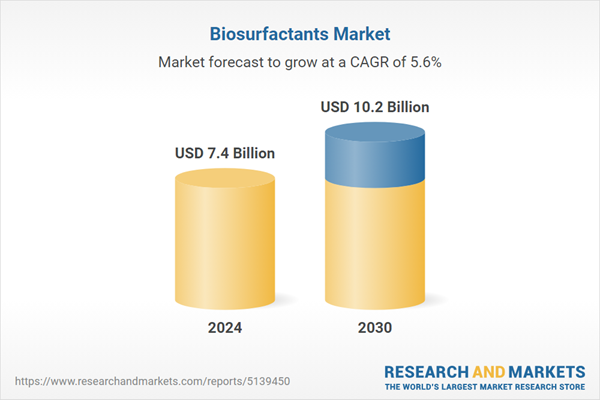The global market for Biosurfactants was valued at US$7.4 Billion in 2024 and is projected to reach US$10.2 Billion by 2030, growing at a CAGR of 5.6% from 2024 to 2030. This comprehensive report provides an in-depth analysis of market trends, drivers, and forecasts, helping you make informed business decisions. The report includes the most recent global tariff developments and how they impact the Biosurfactants market.
Segments: Type (Glycolipids, Lipopeptides, Phospholipids & Fatty Acids, Polymeric Biosurfactants, Particulate Biosurfactants); Application (Detergents, Personal Care, Agricultural Chemicals, Food Processing, Other Applications).
Geographic Regions/Countries: World; United States; Canada; Japan; China; Europe (France; Germany; Italy; United Kingdom; and Rest of Europe); Asia-Pacific; Rest of World.
The analysts continuously track trade developments worldwide, drawing insights from leading global economists and over 200 industry and policy institutions, including think tanks, trade organizations, and national economic advisory bodies. This intelligence is integrated into forecasting models to provide timely, data-driven analysis of emerging risks and opportunities.
Global Biosurfactants Market - Key Trends and Drivers Summarized
What Are Biosurfactants and What Is Their Significance?
Biosurfactants are naturally derived surface-active agents produced by microorganisms such as bacteria, fungi, and yeast. Unlike their synthetic counterparts, biosurfactants are biodegradable, non-toxic, and produced from renewable resources, making them highly desirable in various industrial applications. These compounds reduce surface and interfacial tension, enabling them to emulsify, disperse, and solubilize hydrophobic substances. Due to their versatile nature, biosurfactants are utilized across numerous sectors, including agriculture, pharmaceuticals, food processing, cosmetics, and environmental management. Their environmental compatibility and functional efficiency have positioned them as a sustainable alternative to conventional surfactants, particularly as industries increasingly prioritize green chemistry and eco-friendly practices.How Are Technological Innovations Shaping the Biosurfactants Market?
The biosurfactants market has seen remarkable growth, driven largely by technological advancements that enhance production efficiency and application potential. Cutting-edge biotechnological techniques, including genetic engineering and metabolic pathway optimization, have significantly increased the yield and cost-effectiveness of biosurfactant production. For instance, advances in fermentation technology have enabled the large-scale production of biosurfactants, reducing the overall cost and making them more competitive with synthetic options. Additionally, novel extraction and purification processes have improved the quality and purity of biosurfactants, making them suitable for high-value applications such as pharmaceuticals and personal care products. These technological strides are not only boosting the market's growth but are also expanding the range of applications for biosurfactants, as they meet the stringent quality requirements of various industries.What Trends Are Driving the Increased Adoption of Biosurfactants?
The growing shift towards sustainability and eco-friendly practices is a major trend propelling the adoption of biosurfactants across different industries. In the cosmetics and personal care sectors, there is a strong consumer demand for natural and organic ingredients, leading to a rise in the use of biosurfactants in products like shampoos, soaps, and creams. Similarly, the food and beverage industry is increasingly favoring biosurfactants for their natural origin and non-toxic nature, aligning with the trend toward clean-label products. The environmental sector also benefits from biosurfactants, particularly in bioremediation efforts to clean up oil spills and other contaminants, where their ability to break down pollutants is highly valued. The agricultural industry is another key adopter, as biosurfactants offer a safer alternative to chemical surfactants, enhancing the effectiveness of pesticides and fertilizers without harming the environment. These trends are underscored by a global shift towards greener, more sustainable solutions, further driving the demand for biosurfactants.What’s Fueling the Growth of the Biosurfactants Market?
The growth in the biosurfactants market is driven by several factors, each contributing to the increasing demand for these eco-friendly compounds. One of the primary drivers is the rising consumer preference for natural and sustainable products, especially in personal care and household cleaning sectors, where biosurfactants are seen as safer and more environmentally responsible alternatives to synthetic surfactants. Technological advancements in bioprocessing and fermentation have also played a critical role, reducing production costs and improving the scalability of biosurfactants, making them more accessible for large-scale industrial applications. Regulatory pressures to reduce environmental pollution and the increasing adoption of green chemistry principles are further propelling the market, as industries seek to comply with stringent environmental standards. Moreover, the expanding applications of biosurfactants in emerging fields like nanotechnology and drug delivery are opening new opportunities for market growth. Together, these factors are creating a dynamic and rapidly evolving market for biosurfactants, with significant potential for future expansion.Report Scope
The report analyzes the Biosurfactants market, presented in terms of units. The analysis covers the key segments and geographic regions outlined below.Segments: Type (Glycolipids, Lipopeptides, Phospholipids & Fatty Acids, Polymeric Biosurfactants, Particulate Biosurfactants); Application (Detergents, Personal Care, Agricultural Chemicals, Food Processing, Other Applications).
Geographic Regions/Countries: World; United States; Canada; Japan; China; Europe (France; Germany; Italy; United Kingdom; and Rest of Europe); Asia-Pacific; Rest of World.
Key Insights:
- Market Growth: Understand the significant growth trajectory of the Glycolipids segment, which is expected to reach US$4.0 Billion by 2030 with a CAGR of a 5.9%. The Lipopeptides segment is also set to grow at 5.5% CAGR over the analysis period.
- Regional Analysis: Gain insights into the U.S. market, valued at $2.0 Billion in 2024, and China, forecasted to grow at an impressive 5.4% CAGR to reach $1.6 Billion by 2030. Discover growth trends in other key regions, including Japan, Canada, Germany, and the Asia-Pacific.
Why You Should Buy This Report:
- Detailed Market Analysis: Access a thorough analysis of the Global Biosurfactants Market, covering all major geographic regions and market segments.
- Competitive Insights: Get an overview of the competitive landscape, including the market presence of major players across different geographies.
- Future Trends and Drivers: Understand the key trends and drivers shaping the future of the Global Biosurfactants Market.
- Actionable Insights: Benefit from actionable insights that can help you identify new revenue opportunities and make strategic business decisions.
Key Questions Answered:
- How is the Global Biosurfactants Market expected to evolve by 2030?
- What are the main drivers and restraints affecting the market?
- Which market segments will grow the most over the forecast period?
- How will market shares for different regions and segments change by 2030?
- Who are the leading players in the market, and what are their prospects?
Report Features:
- Comprehensive Market Data: Independent analysis of annual sales and market forecasts in US$ Million from 2024 to 2030.
- In-Depth Regional Analysis: Detailed insights into key markets, including the U.S., China, Japan, Canada, Europe, Asia-Pacific, Latin America, Middle East, and Africa.
- Company Profiles: Coverage of players such as Agae Technologies, LLC, Biotensidon GmbH, Ecover UK Ltd, Evonik Corporation, Jeneil Biotech, Inc. and more.
- Complimentary Updates: Receive free report updates for one year to keep you informed of the latest market developments.
Some of the 44 companies featured in this Biosurfactants market report include:
- Agae Technologies, LLC
- Biotensidon GmbH
- Ecover UK Ltd
- Evonik Corporation
- Jeneil Biotech, Inc.
- Logos Technologies
- Saraya Co., Ltd.
- Soliance SA
Tariff Impact Analysis: Key Insights for 2025
Global tariff negotiations across 180+ countries are reshaping supply chains, costs, and competitiveness. This report reflects the latest developments as of April 2025 and incorporates forward-looking insights into the market outlook.The analysts continuously track trade developments worldwide, drawing insights from leading global economists and over 200 industry and policy institutions, including think tanks, trade organizations, and national economic advisory bodies. This intelligence is integrated into forecasting models to provide timely, data-driven analysis of emerging risks and opportunities.
What’s Included in This Edition:
- Tariff-adjusted market forecasts by region and segment
- Analysis of cost and supply chain implications by sourcing and trade exposure
- Strategic insights into geographic shifts
Buyers receive a free July 2025 update with:
- Finalized tariff impacts and new trade agreement effects
- Updated projections reflecting global sourcing and cost shifts
- Expanded country-specific coverage across the industry
Table of Contents
I. METHODOLOGYII. EXECUTIVE SUMMARY2. FOCUS ON SELECT PLAYERSIII. MARKET ANALYSISIV. COMPETITION
1. MARKET OVERVIEW
3. MARKET TRENDS & DRIVERS
4. GLOBAL MARKET PERSPECTIVE
UNITED STATES
CANADA
JAPAN
CHINA
EUROPE
FRANCE
GERMANY
ITALY
UNITED KINGDOM
REST OF EUROPE
ASIA-PACIFIC
REST OF WORLD
Companies Mentioned (Partial List)
A selection of companies mentioned in this report includes, but is not limited to:
- Agae Technologies, LLC
- Biotensidon GmbH
- Ecover UK Ltd
- Evonik Corporation
- Jeneil Biotech, Inc.
- Logos Technologies
- Saraya Co., Ltd.
- Soliance SA
Table Information
| Report Attribute | Details |
|---|---|
| No. of Pages | 193 |
| Published | April 2025 |
| Forecast Period | 2024 - 2030 |
| Estimated Market Value ( USD | $ 7.4 Billion |
| Forecasted Market Value ( USD | $ 10.2 Billion |
| Compound Annual Growth Rate | 5.6% |
| Regions Covered | Global |









